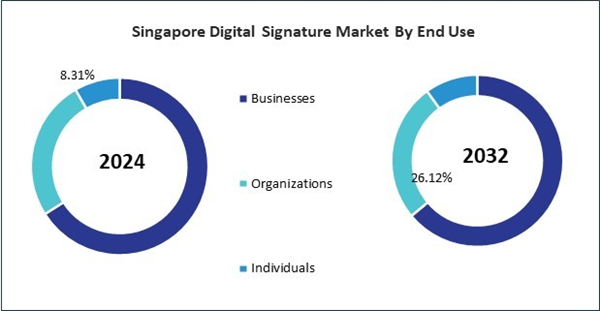The China market dominated the Asia Pacific Digital Signature Market by country in 2024, and is expected to continue to be a dominant market till 2032; thereby, achieving a market value of $5.38 billion by 2032. The Japan market is registering a CAGR of 40.1% during 2025-2032. Additionally, the India market is expected to showcase a CAGR of 42% during 2025-2032.
In the healthcare sector, digital signatures play a vital role in ensuring the integrity of electronic health records (EHRs), e-prescriptions, patient consent forms, and insurance documents. Compliance with regulations such as HIPAA (Health Insurance Portability and Accountability Act) in the US, which mandates stringent protection for patient data, is facilitated through the secure and auditable nature of digital signatures. The legal industry benefits immensely from the use of digital signatures for contracts, affidavits, and court filings.
The capability to sign legal documents electronically accelerates legal processes, reduces delays, and maintains an auditable trail for future reference. Similarly, in the real estate sector, digital signatures enable seamless execution of sales agreements, lease contracts, and property transfers, often leading to faster closing cycles and enhanced client satisfaction. Corporate environments, regardless of sector, utilize digital signatures in a multitude of ways - from internal approvals and HR documentation to supply chain management and procurement.
The Asia Pacific digital signature market has experienced rapid transformation over the past two decades, evolving alongside the region’s sweeping digitalization and the modernization of legal frameworks. The foundation for the digital signature market was laid by national governments introducing regulations to legitimize and standardize electronic signatures. Countries like Singapore, India, Australia, China, and Japan were among the early adopters, implementing acts such as the Singapore Electronic Transactions Act (1998), India’s Information Technology Act (2000), and Australia’s Electronic Transactions Act (1999). These laws established the legal equivalence of electronic and handwritten signatures, which paved the way for digital signatures in e-governance, business, and finance.
With the rise of digital economies and widespread mobile adoption, Asia Pacific governments expanded digital signature applications to include e-government portals, financial services, and trade. Singapore’s Smart Nation initiative, India’s Digital India campaign, and China’s push for a digital society all prioritized secure digital authentication. OEMs such as DocuSign, Adobe, and local players like eMudhra, Securemetric, and Certis developed regionally tailored solutions to comply with both global and local regulations. Business magazines and regional technology publications have spotlighted the use of digital signatures to reduce paperwork, boost efficiency, and secure transactions in fast-growing markets.
A crucial strategy is investment in compliance and certification. Market leaders actively work with government agencies, regulatory authorities, and industry groups to obtain certifications under country-specific laws and standards. This includes collaborating on digital trust initiatives, contributing to the development of regional interoperability standards, and participating in national pilots for e-signature integration with public services. Many leaders have also prioritized partnerships with banks, insurers, telecom providers, and large enterprises to drive enterprise-wide adoption of digital signature workflows. The fast pace of digital transformation across sectors - particularly finance, government, health, and education - ensures that the Asia Pacific market remains dynamic, with continuous innovation and a steady influx of new entrants aiming to capture market share.
List of Key Companies Profiled
- DocuSign, Inc.
- Adobe, Inc.
- PandaDoc Inc.
- Dropbox, Inc.
- Zoho Corporation Pvt. Ltd.
- Thales Group S.A.
- GMO GlobalSign Pte. Ltd (GMO Internet Group, Inc.)
- IdenTrust, Inc. (HID Global Corporation)
- Sertifier INC.
- GetAccept, Inc.
Market Report Segmentation
By Level
- Advanced Electronic Signatures (AES)
- Qualified Electronic Signatures (QES)
By Component
- Solutions
- Services
By Deployment Model
- Cloud
- On-premise
By End Use
- Businesses
- Organizations
- Individuals
By Industry Vertical
- BFSI
- Healthcare & Life Sciences
- IT & Telecom
- Government
- Retail
- Other End User
By Country
- China
- Japan
- India
- South Korea
- Singapore
- Malaysia
- Rest of Asia Pacific
Table of Contents
Companies Mentioned
- DocuSign, Inc.
- Adobe, Inc.
- PandaDoc Inc.
- Dropbox, Inc.
- Zoho Corporation Pvt. Ltd.
- Thales Group S.A.
- GMO GlobalSign Pte. Ltd (GMO Internet Group, Inc. )
- IdenTrust, Inc. (HID Global Corporation)
- Sertifier INC.
- GetAccept, Inc.









